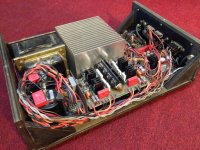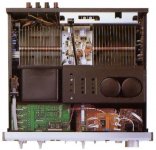Good evening.
I have some questions that I would like to ask in plain and simple language and get replies in plain and simple language. People who are intelligent, refined and sophisticated would probably look upon these questions as stupid questions. Does anyone know of another forum that would accommodate stupid questions?
If you do, please point me in the right direction. Thank you. Jim
I have some questions that I would like to ask in plain and simple language and get replies in plain and simple language. People who are intelligent, refined and sophisticated would probably look upon these questions as stupid questions. Does anyone know of another forum that would accommodate stupid questions?
If you do, please point me in the right direction. Thank you. Jim
Well, okay. I'll try it.
It was my impression that when a speaker in a ported system hits a note at the port resonance, the speaker diaphragm is held still, or almost still.
What if the port resonance is 60 cycles, and the recording has a significant amount of information at 120 cycles? How will that speaker diaphragm reproduce the 120 cycle information now that it's at the minimum-motion point?
In other words, I wonder whether the 120 cycle sound is reduced because the total excursion is reduced.
Is this problem real or not? If it is, is it audible?
Thanks for listening to one of my stupid questions. jj
It was my impression that when a speaker in a ported system hits a note at the port resonance, the speaker diaphragm is held still, or almost still.
What if the port resonance is 60 cycles, and the recording has a significant amount of information at 120 cycles? How will that speaker diaphragm reproduce the 120 cycle information now that it's at the minimum-motion point?
In other words, I wonder whether the 120 cycle sound is reduced because the total excursion is reduced.
Is this problem real or not? If it is, is it audible?
Thanks for listening to one of my stupid questions. jj
Last edited:
The cone is only at the minimum excursion point at 60Hz, adding another frequency will add more excursion at the new added frequency. The new frequency doesn't affect the output at 60Hz.
This question is definitely not in the 'stupid' category, it shows original thinking. Keep such questions up
This question is definitely not in the 'stupid' category, it shows original thinking. Keep such questions up
I apologize, but I don't understand. Perhaps I need to make my question clearer.
I know NOTHING about the required excursions for different sound levels, but let's take an arbitrary set of numbers. They are probably totally unrealistic.
Let's say that the 120 cycle sound is a loud drum. And let's also say that the cone needs to move 1mm to reproduce that drum. The 60 cycle sound is a bass guitar. When the bass note (60 cycles) is played, the cone is at its minimum-motion point. Let's say it is only moving back and forth a tenth of a millimeter at this point.
But the drum requires 1mm of back-and-forth motion to be reproduced to the same degree of accuracy that it had been reproduced when the bass was not playing.
It doesn't have that 1mm of movement anymore, does it? I mean, if the cone is RIGID, then it doesn't have that 1mm of movement. That's what I'm trying to say .... or ask.
Maybe there are other methods of flexure to cones when they are held at the minimum-motion point, no? Maybe they aren't as rigid as I had thought.
As always, thank you. jj
I know NOTHING about the required excursions for different sound levels, but let's take an arbitrary set of numbers. They are probably totally unrealistic.
Let's say that the 120 cycle sound is a loud drum. And let's also say that the cone needs to move 1mm to reproduce that drum. The 60 cycle sound is a bass guitar. When the bass note (60 cycles) is played, the cone is at its minimum-motion point. Let's say it is only moving back and forth a tenth of a millimeter at this point.
But the drum requires 1mm of back-and-forth motion to be reproduced to the same degree of accuracy that it had been reproduced when the bass was not playing.
It doesn't have that 1mm of movement anymore, does it? I mean, if the cone is RIGID, then it doesn't have that 1mm of movement. That's what I'm trying to say .... or ask.
Maybe there are other methods of flexure to cones when they are held at the minimum-motion point, no? Maybe they aren't as rigid as I had thought.
As always, thank you. jj
Last edited:
It doesn't have that 1mm of movement anymore, does it? I mean, if the cone is RIGID, then it doesn't have that 1mm of movement. That's what I'm trying to say .... or ask.
The cone isn't rigid, it keeps all its original mechanical properties. It only doesn't move (actually it does but very little, depending on the Q) for the 60Hz component that's sent to it. So it still has the 1mm excursion available to it for additional frequencies.
Maybe there are other methods of flexure to cones when they are held at the minimum-motion point, no? Maybe they aren't as rigid as I had thought.
Perhaps your confusion arises from this word 'held'. Nothing extra is 'holding' the cone when its at resonance. Its just that the port's doing all the 'work'. It doesn't 'go rigid' rather just appears that way, only at one frequency.
Well, this one is about amps.
If you have a laptop computer, it probably has what some people call a "heat pipe". I don't know what the chemical is in the heat pipe, but I know that 30 years ago there were heat transfer tubes that were filled with Freon.
Solid state amps that operate in class "A" produce a lot of heat. Why do none of them use this "heat pipe"?
Wouldn't that help the amp in summertime?
Wouldn't it extend the useful life of the amp?
As always, thank you. jj
If you have a laptop computer, it probably has what some people call a "heat pipe". I don't know what the chemical is in the heat pipe, but I know that 30 years ago there were heat transfer tubes that were filled with Freon.
Solid state amps that operate in class "A" produce a lot of heat. Why do none of them use this "heat pipe"?
Wouldn't that help the amp in summertime?
Wouldn't it extend the useful life of the amp?
As always, thank you. jj
AH! I see. I had thought that a heat pipe might be "better" than a heat sink. Thank you.
My next question has to do with room treatment.
Why not carpet the walls? Carpet is heavy, but walls are strong. Carpet is good at deadening sound. I have seen pictures of professional studios as well as home studios. Not a single one of them had carpet on the wall as a sound deadener.
Why not? Why is it not desirable for that use? After all, it's attractive.
Thanks. jj
My next question has to do with room treatment.
Why not carpet the walls? Carpet is heavy, but walls are strong. Carpet is good at deadening sound. I have seen pictures of professional studios as well as home studios. Not a single one of them had carpet on the wall as a sound deadener.
Why not? Why is it not desirable for that use? After all, it's attractive.
Thanks. jj
Solid state amps that operate in class "A" produce a lot of heat. Why do none of them use this "heat pipe"?
I agree they could use a heatpipe, just there's more flexibility about where the hot parts (transistors) can be placed in an amp, compared to in a laptop. The heatpipe is used there because of the difficulty of getting the heat out of a CPU which is deep inside a slim case. Also heatsinks tend to be heavy and thus not desirable in a portable device - a fan is used to take heat away from the heatpipe, that's lower weight. Fans are generally frowned on in domestic audio amps because of the noise they generate, though they're popular in professional ones.
About carpets on walls, I dunno. Maybe there are other more effective ways of deadening walls than using carpet.
It is due to the WAF* that all we know very well.My next question has to do with room treatment.
Why not carpet the walls? Carpet is heavy, but walls are strong. Carpet is good at deadening sound. I have seen pictures of professional studios as well as home studios. Not a single one of them had carpet on the wall as a sound deadener.
Why not? Why is it not desirable for that use? After all, it's attractive.
Thanks. jj
(*WAF: Wife Acceptance Factor. A common issue audio enthusiasts encounter in their daily life, and very difficult (if not impossible) to overcome)
Studios do use carpet substitutions, with controlled absorption at different frequencies. They are called acoustic panels. And have REALLY low WAF. If you just glued an arbitray carpet to your wall you may end up with worse sound because the carpet reflects and absorbed at freq:s that not accomodate with the room resonances or your speakers. But of course anyone can try, its cheap to try. Egg cartons was common a few yars ago. My girlfriend didnt like them.
...My girlfriend didnt like them.
Now that is GAF (Girlfriend Acceptance Factor)
There is also LILAF (Live In Lover Acceptance Factor)
But I have no idea if WAF = GAF = LILAF
- Status
- This old topic is closed. If you want to reopen this topic, contact a moderator using the "Report Post" button.
- Home
- Member Areas
- The Lounge
- different audio forum

